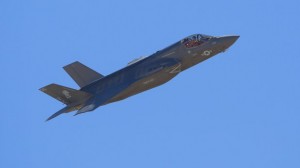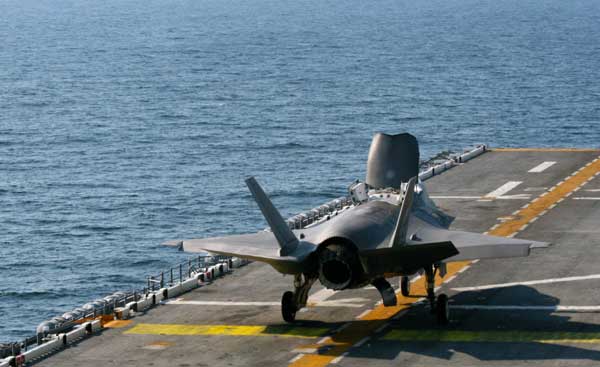10/12/2014: F-35 Lightning II with Marine Fighter Attack Squadron (VMFA) 121 performing at the 2014 Miramar Air Show aboard Marine Corps Air Station Miramar, Calif., Oct. 4.
The show was noteworthy for marking both the end of an era and a beginning.
The CH-46 flew at the air show at the time when the last CH-46 squadron was being redesignated as an Osprey squadron and the F-35 B made an appearance at the air show.
Credit: Marine Corps Air Station Miramar / 3rd Marine Aircraft Wing:10/14/14
According to an article by Gretel C. Kovach in the UTS San Diego paper:
Spectators at the Miramar Air Show witnessed the end of an era in Marine aviation and a beginning, when a helicopter that served in the Vietnam War flew its last active duty performance and a stealthy, supersonic F-35B fighter jet flew its San Diego debut.
The CH-46 Sea Knight helicopter is being retired from Marine Corps service and replaced by the MV-22 Osprey tilt-rotor, which can fly faster and farther carrying more weight. The Marine Corps’ last operational squadron of the 1960s-era helicopter will be re-designated this month, making Camp Pendleton-based Marine Medium Helicopter Squadron 364 an Osprey squadron.
One of the snub-nosed, tandem rotor CH-46s, also affectionately called the “Battle Phrog,” was painted in Vietnam-era glossy green. As it flew ahead of three others in standard gunmetal gray, the Marine announcer said the historic aircraft was a tribute to veterans from that long-ago war, eliciting whoops and applause Saturday.
The F-35B Lightning II, the Marine variant of the Joint Strike Fighter under development by lead contractor Lockheed Martin for three services, later demonstrated its ability to hover and land at speeds of just 60 mph on a relatively short strip of runway.

The Corps created the Pentagon’s first operational squadron of F-35 planes in 2012. Yuma-based Marine Fighter Attack Squadron 121 has since flown more than 1,000 sorties totaling about 1,700 flight hours.
The Marine Corps said its plan to become the first service to declare initial operational capability for the jet, in July 2015, is on track despite the temporary grounding of the entire F-35 fleet this summer because of an engine malfunction in the Air Force version.
“This is the most advanced and newest fighter aircraft in the world. … the future of Marine aviation,” Col. John Farnam, commanding officer of Marine Corps Air Station Miramar, said in opening remarks…..
It’s not the full capability … but we will have weapons integrated, we will have combat capability. And the Marine Corps is raising its hand, saying ‘combatant commanders and Mr. President, … it’s available,” said Gillette, 42, of Lincoln, Neb.
In Yuma and Twentynine Palms the “Green Knights” have been flying in large scale combat exercises, dropping simulated ordnance and making vertical landings.
They currently are restricted to flying at 450 knots. With 2B software the speed limit rises to 550 knots, they can drop live ordnance, and the flight envelope opens to a greater angle of attack and G-loads.
Under full capability, the F-35B will sustain 7 Gs, compared to 9 for the Air Force version.
Gillette said the jet is easy to fly, requiring only six simulator or other training events for a pilot to learn to hover, versus nearly 30 in a Harrier. Even former F/A-18 Hornet pilots like himself with no experience in hover find it relatively simple, he said.
“Just in the infancy of the F-35 the state-of-the-art sensors and the software that drives those sensors is amazing to see from the cockpit perspective.”
http://www.utsandiego.com/news/2014/oct/04/miramar-air-show-marine-aviation-f35-ch46/all/?print
The Osprey Transition
The Osprey transition has not been an easy one.
It has involved cultural change, concepts of operations changes, significant change in maintenance approaches and operations, just to mention a few of the gut wrenching changes required of the USMC.
But now the USMC is the only tiltorotar enabled assault force in the world and able to reshape amphibious assault, establish new entities such as the Special Purpose MAGTF, and to shape innovative 21st century operations.
In a piece written by Robbin Laird and published in Breaking Defense, the challenges of transition was highlighted:
When I first saw Ospreys at New River several years ago, there were only five. Now a newly appointed Air Combat Element or ACE commander for the 22nd Marine Expeditionary Force, Lt. Col. Schoolfield, showed me the air group being assembled on the tarmac. It was an impressive array of aircraft, including the newly configured AH-1Z Cobras and UH-1Y “Yankees.”
The Ospreys were lined up almost as if they knew that they were the enabler now of the afloat Marines, and not an experiment. But to get to this point has required significant cultural change within the Corps itself. To deal with this requires leadership, and not just inside the Beltway. Commanders in the field and with the forces are crucial to such change.
One such leader is the retiring (in only one sense of the word) Col. Seymour, who is the CO of Marine Aircraft Group 26. During our interview, Seymour described the cultural changes necessary to deal with process of change. Leadership had to move forward in spite of resistance. As he reminded his Marines: “You are not stakeholders; you are Marines. Get on with it.”
The F-35B Transformation
We recently visited the first operational squadron of F-35Bs, the squadron which flew the F-35Bs seen at Miramar.
In an interview with the Executive Officer of the Squadron, the Lt. Col. designate to be the CO of an F-35 squadron at Beaufort underscored the nature of the transformation:
Question: How would you describe the current role of the squadron?
Major Summa:
The Marines focus on a process of giving the airplane to the operators and let the operators figure out how best to operate and then use the aircraft.
Our leadership has prepared the way for the coming of the F-35 to the USMC and has worked hard to ensure that the infrastructure is in place to allow us to train and use the aircraft.
For example, when Lt. General Trautman was Deputy Commandant of Aviation he focused on preparing Yuma to be the home for the first F-35 squadron.
Clearly, being here with MAWTS-1 gives us a good advantage to get a good start on operating, training and shaping the tactics of the new aircraft for the MAGTF.
After creating the infrastructure, the next step was to get the airplane in the hands of Marines to work with the aircraft and to work with the aircraft within the limits of what it is cleared to do, because we do not have clearance for the full flight envelope we will have by the time the aircraft attains Initial Operational Capability.
Question: Putting the plane in the hands of the operators is a key part of developing the aircraft as well isn’t it?
Major Summa:
It is. Every time we fly, we are learning something.
While trained Test Pilots are operating instrumented aircraft on a detailed test plan, in Yuma you have operational pilots flying the jet everyday gaining data points that may not have been discovered by Developmental Test.
By data points I do not mean safety of flight related items, I am referring to operational data points.
More along the lines of how to optimize and use the multiple sensors to accomplish a task or execute a mission set.
Since we have such a good working relationship with the Developmental Test entities, the Joint Operational Test community, and the individuals from industry who are SMEs on the systems, we can get immediate feedback when questions arise and then promulgate that back out to the community.
For example, last week we spent several hours in the vault with pilot training officers and with pilots who have been either MAWTS or Top Gun graduates or instructors.
We compared our operational experience with what has been developed so far with regard to our joint tactics manual which was written more than year ago, based on expectations developed from flying in the simulator.
Now we are seeing things in the operational airplane.
So how do we change?
How do we improve, update and morph the manual to where we see the plane operationally performing?
Where do we think we are going with the next drop of software in the plane?
On the end of the CH-46 era and the redesignation of the last CH-46 squadron see the following:
https://sldinfo.com/the-end-of-an-era-last-ch-46-squadron-redesignates/


